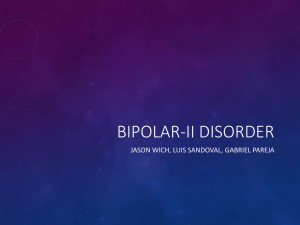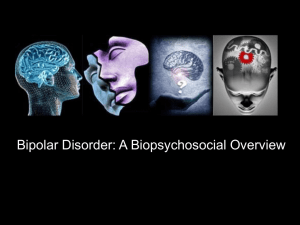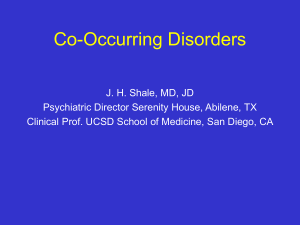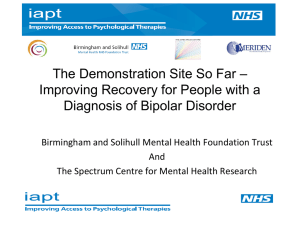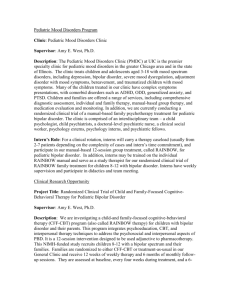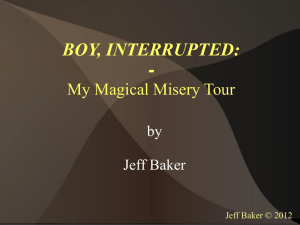Newsletter - Nicholas Perfetto
advertisement
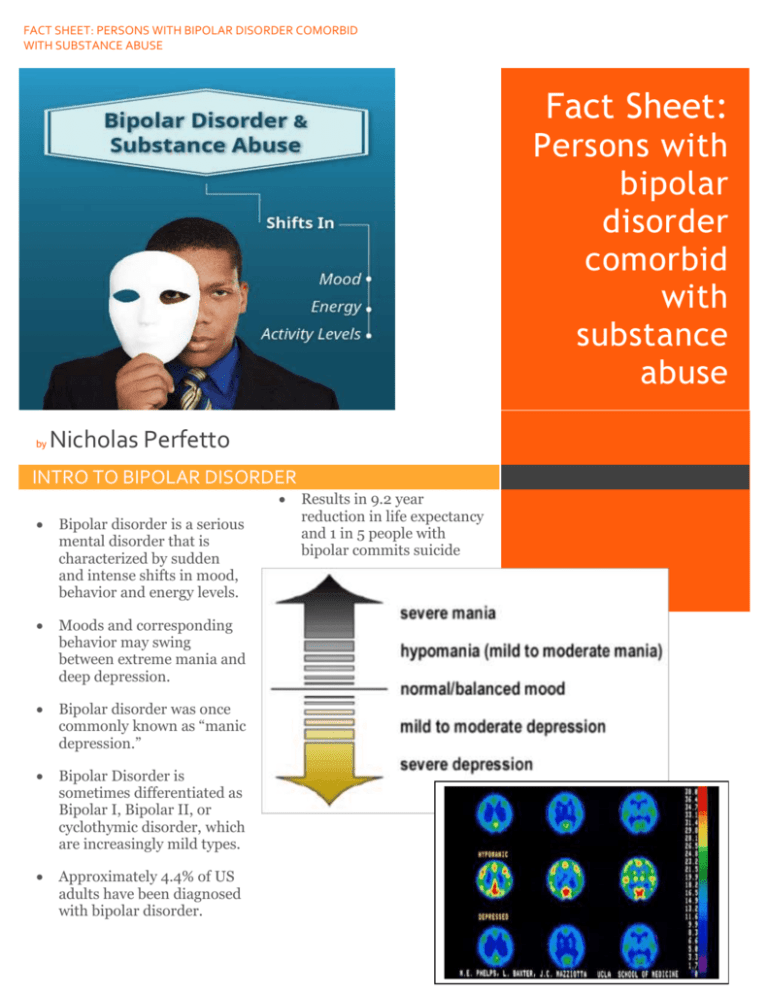
FACT SHEET: PERSONS WITH BIPOLAR DISORDER COMORBID WITH SUBSTANCE ABUSE Fact Sheet: Persons with bipolar disorder comorbid with substance abuse by Nicholas Perfetto INTRO TO BIPOLAR DISORDER Bipolar disorder is a serious mental disorder that is characterized by sudden and intense shifts in mood, behavior and energy levels. Moods and corresponding behavior may swing between extreme mania and deep depression. Bipolar disorder was once commonly known as “manic depression.” Bipolar Disorder is sometimes differentiated as Bipolar I, Bipolar II, or cyclothymic disorder, which are increasingly mild types. Approximately 4.4% of US adults have been diagnosed with bipolar disorder. Results in 9.2 year reduction in life expectancy and 1 in 5 people with bipolar commits suicide FACT SHEET: PERSONS WITH BIPOLAR DISORDER COMORBID WITH SUBSTANCE ABUSE | 2 ee Comorbidity with SUDs Bipolar disorders have been linked to increased substance abuse at varying rates. Most estimates put the rates of comorbidity at 45-60%. The more pervasive the symptoms and diagnosis (i.e. bipolar I vs bipolar II), the more commonly comorbid with substance abuse disorders (SUDs). Persons with bipolar may be seeking to ease the painful symptoms of their depression through selfmedication with drugs and alcohol During their mania or hypomania (mild mania), their false confidence, high energy and mood, and increased impulsivity may make them more inclined to thrill-seek or make risky decisions, such as those involving drugs and alcohol. Many different substances are abused, and they may correlate with different mood states: for example, Strakowski, et al. (2000) found that alcohol use correlated with depressed states, but cannabis use with manic states. As shown below, bipolar disorder is comorbid with many other serious conditions, including substance abuse disorders. DISAGREEMENT IN RESEARCH IN MANY STUDIES, THE RESEARCHERS FOUND THAT COMORBIDITY RATES RANGED FROM 14-60%. THIS WIDE RANGE COULD BE DUE TO A NUMBER OF FACTORS INCLUDING CONTEXT AND SAMPLE SIZE (CASSIDY, AHEARN, & CARROLL, 2001) FACT SHEET: PERSONS WITH BIPOLAR DISORDER COMORBID WITH SUBSTANCE ABUSE | 3 ee TREATMENT AND PROGNOSIS While persons with bipolar disorder may abuse substances as a way to gain control or stabilize their mood, they actually make the symptoms worse and more volatile. Because the substance abuse disorders and bipolar are so closely connected, they can and should be treated together. This integrated treatment philosophy allows for flexibility in treatment. Alcohol and marijuana are most commonly abused by persons with bipolar disorder, but narcotics and other hard drugs are also commonly abused. Psychosocial interventions can be mixed with medical treatments, and can be administered by a team of professionals, in a group setting, etc. Medical Treatment Pharmacotherapy Treatment Pharmacotherapy Treatment Options Options Options Lithium o Treatment for mania and impulsivity o Can be paired successfully with anticonvulsant drugs Lamotrigine Valproate Depakote Antipsychotics o Clozapine o Aripiprazole o Olanzapine Antidepressants o Fluoxetine Drug combinations of the above as prescribed Psychosocial Treatment Psychosocial Treatment Psychosocial Treatment Options Options Options Cognitive Behavioral Therapy (CBT) Dialectical Behavior Therapy (DBT) Psychotherapy for managing emotions Group and peer counseling Specialized Relapse Prevention Support groups such as Alcoholics Anonymous or Narcotics Anonymous FACT SHEET: PERSONS WITH BIPOLAR DISORDER COMORBID WITH SUBSTANCE ABUSE | 4 ee o o o o Many patients receiving simultaneous treatment dropout of treatment Many also have serious social barriers or conditions, such as homelessness or serious medical issues Simultaneous treatment may involve complicated pharmacotherapeutic combinations o It also requires heavy communication and collaboration between physician/psychiatrist and counselor/addiction counselor Bipolar is often misdiagnosed as depression or other mood disorders, and drug use can complicate symptoms and increase the chance of misdiagnosis The following websites, along with local addiction centers and support groups such as AA and NA chapter, can be consulted for bipolar and bipolar comorbid with SUDs. o https://www.aacap.org/aacap/Families_and_Youth/Resource_Centers/Bipol ar_Disorder_Resource_Center/Home.aspx o http://www.isbd.org/advocacy-and-patient-resources/patient-resources o http://www2.nami.org/Template.cfm?Section=Bipolar1&Template=/Conte ntManagement/ContentDisplay.cfm&ContentID=130663 o http://www.dbsalliance.org/site/PageServer?pagename=home o http://psychcentral.com/lib/resources-for-bipolar-disorder/ FACT SHEET: PERSONS WITH BIPOLAR DISORDER COMORBID WITH SUBSTANCE ABUSE | 5 ee References Bipolar disorder (n.d.) University of Colorado, Colorado Springs. Retrieved July 17, 2015. http://www.uccs.edu/biology-educational-resources/mood-disorders/bipolar-disorder.html Bipolar disorder and addiction. (n.d.). Dual Diagnosis. Retrieved July 17, 2015. Bipolar disorder and substance abuse - Are they connected? (2014, March 27). RehabCenter.net. Retrieved July 17, 2015. Brown, E. S., Jeffress, J., Liggin, J. D., Garza, M., & Beard, L. (2005). Switching outpatients with bipolar or schizoaffective disorders and substance abuse from their current antipsychotic to aripiprazole. Journal of Clinical Psychiatry. Cassidy, F., Ahearn, E. P., & Carroll, B. J. (2001). Substance abuse in bipolar disorder. Bipolar Disorders, 3(4), 181-188. Feinman, J. A., & Dunner, D. L. (1996). The effect of alcohol and substance abuse on the course of bipolar affective disorder. Journal of affective disorders,37(1), 43-49. Geller, B., Cooper, T. B., Sun, K. A. I., Zimerman, B., Frazier, J., Williams, M., & Heath, J. (1998). Double-blind and placebo-controlled study of lithium for adolescent bipolar disorders with secondary substance dependency. Journal of the American Academy of Child & Adolescent Psychiatry, 37(2), 171-178. Goldberg, J. (n.d.). Bipolar Depression and Substance Abuse: Which Is the Driving Force? Retrieved July 17, 2015 Goldberg, J. F., Garno, J. L., Leon, A. C., Kocsis, J. H., & Portera, L. (1999). A history of substance abuse complicates remission from acute mania in bipolar disorder. The Journal of clinical psychiatry, 60(11), 733-740. Levin, F. R., & Hennessy, G. (2004). Bipolar disorder and substance abuse. Biological psychiatry, 56(10), 738748. FACT SHEET: PERSONS WITH BIPOLAR DISORDER COMORBID WITH SUBSTANCE ABUSE | 6 ee Ozten, M., Erol, A., Karayilan, S., Kapudan, H., Orsel, E. S., & Kumsar, N. A. (2015). Impulsivity in bipolar and substance use disorders. Comprehensive psychiatry, 59, 28-32. Prevalence and age of onset of bipolar disorders in the general population. (n.d.). Bipolar Lab Retrieved July 17, 2015. Salloum, I. M., & Thase, M. E. (2000). Impact of substance abuse on the course and treatment of bipolar disorder. Bipolar disorders, 2(3p2), 269-280. Strakowski, S. M., DelBello, M. P., Fleck, D. E., & Arndt, S. (2000). The impact of substance abuse on the course of bipolar disorder. Biological psychiatry, 48(6), 477-485.



